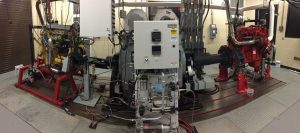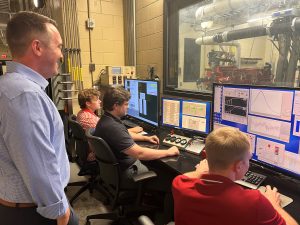Joshua Bittle
Associate Professor – Department of Mechanical Engineering
Associate Director – Center for Advanced Vehicle Technologies
https://jbittle.people.ua.edu
https://scholar.google.com/citations?user=dEM8ysoAAAAJ&hl=en
Paulius Puzinauskas
Associate Professor – Department of Mechanical Engineering
Staff: John O’Donnell, Mehmet Cellek
Students: Spencer Hall, Chris Perkins, Christian Acosta, Will Baschab, Allen Loper, Allen Parker
Heavy-Duty Engines lab houses a 660 hp double-ended high-torque engine dynamometer capable of testing Class 8 engines with 40 C.F.R. § 86.133 certification capabilities. Currently the facility features a Cummins ISX15 450ST on one end and a rotating set of engines on the other end. Engine controls are developed using LabVIEW-based and MATLAB Simulink-based open engine control hardware/software as well as stock OEM equipment. The test cell and engine are primarily monitored and operated with National Instruments hardware for data acquisition and controlled via NI LabVIEW. These systems allow for a range of testing and engine performance characterization, and control strategy testing and development.


The lab features a dilution tunnel for emissions sampling that (a) meets EPA CFR40 Part 1065 specifications for HD Transient emission testing, (b) has exhaust flow range of 3,000 to 10,000 SCFM through 24 in diameter insulated main duct for dilute sampling from engines up to 750 HP, (c) dual AC-powered VSD-controlled blowers, (d) balance pressure at engine stack exit, (e) constant mass flow, and (f) dilution air filtered to 0.3 micron with 99.97% efficiency (HEPA standard).

- Air flow is measured with AVL FlowSonix system and intake air can be heated/depressurized to simulate a range of ambient conditions.
- Transient fuel conditioning and consumption measurement is achieved with remote controlled fuel cart that includes a Coriolis flow meter with added flexibility for alternative and bio-fuel testing.
- An exhaustive suite of custom real-time LabVIEW and post-processing Python script are used and continuously developed.
Emissions measurement capabilities include
- 5-gas emissions bench coupled with full CVS exhaust dilution tunnel,
- Fourier Transform Infrared (FTIR) Analyzer
- Fast NOx/HC Analyzers
- AVL Smoke and Opacimeter
Engine Development We have worked with multiple industry partners to test prototype hardware and control strategies development. This includes testing partner supplied and/or UA developed hardware components. Examples include full prototype engines, individual engine components, and aftertreatment systems. Proprietary advanced engine control strategies can also be tested together with UA developed open engine control systems or using partner supplied ECU devices.
Real-Time Engine Control Advanced real-time control-based emissions mitigation of heavy-duty diesel engines includes both low-temperature combustion modes and transient engine control optimization. Examples include evaluating cyclic behavior during typical engine transients, managing response of the turbocharger and fueling systems, and enabling stable ultra-lean combustion modes that are proven to reduce in-cylinder emissions formation. The overall goal is to reduce the demand on after-treatment systems of heavy-duty engines used for long-haul freight transit.
Alternative Fuels Global reliance on heavy-duty diesel engines has led to significant efforts into developing and finding more environmentally friendly and sustainable fuels and fuel blends to reduce reliance on fossil fuels, while decreasing harmful emissions without a complete shift in technology. Alternative biofuels or bio-derived fuels are attractive for their “drop-in” capability. In coordination with High Pressure Spray laboratory, one focus of this test cell is to determine how blending diesel with alternative and/or biofuels affects the performance and emissions of a realistic multi-cylinder heavy-duty engine.
Research Examples:
Related Publications:
- Cook, J., Puzinauskas, P., Wagenmaker, M., and Bittle, J., “Improved Diesel Engine Load Control for Heavy-Duty Transient Testing Using Gain Scheduling and Feed-forward Algorithms,” SAE Int. J. Engines 16(6):2023.
- Hall, S. and Bittle, J., “Soot and Gaseous Emissions Characterization of Butyl-Acetate/Diesel Blend in a Heavy-Duty Engine,” SAE Technical Paper 2023-01-0267, 2023.